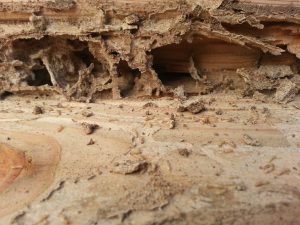Why would anyone building a pole barn, barndominium, shouse or post frame home need to be concerned about treating for termites? Isn’t pressure preservative treated wood going to solve any potential long range problems from pesky termites?
Regardless of whether you build a post frame (pole) building, stick frame, steel frame or even concrete building – if there is any cellulose (wood) based product in your building – you are vulnerable to termites. I have even heard a story about a man who had bags of Sakcrete™ (https://www.hansenpolebuildings.com/2012/11/concrete/) stored in his garage and termites ate away the paper bags!
Properly pressure treated wood will be termite resistant until it is cut or bored and those areas are not protected afterwards.
There is an old adage of “an ounce of prevention is worth more than a pound of cure” is absolutely true, especially when it comes to building and preventing termites. While it is nearly impossible to prevent anything from happening one hundred percent, pre-treating area where your building is to be constructed, can drastically increase your chances of remaining free of termites.
Goal of pre-construction termite treatments is to form an in ground chemical barrier keeping subterranean termites from coming up from the soil to feed on wood structures or wood/cellulose inside them. Because the area to be treated is free of obstructions (such as a building), this type of treatment is less labor intensive, and requires less termiticide to be used, making treatment less expensive than treating an existing structure. Another benefit of pre-treating is your exterminator can cover every square inch of ground, creating a more secure barrier.
In order to properly treat for termites during pre-construction, area will need to have termiticides applied several times at different stages. Your exterminator will need to be in close contact with you or your builder in order to accurately arrange treatments. Your building design and type of soil it is being built upon may cause some variation in barrier application.
While methods can vary a bit depending on building codes for your specific area, first step for pre-construction termite treatment is usually to treat before a concrete slab is poured. Once land has been graded area should be treated. This is usually done by treating with a termiticide barrier at a rate of one gallon of chemical solution per every ten square feet.
While termites cannot bore into or eat concrete, slabs can crack with time creating perfect entry points for them. If surrounding soil has not been treated, termites can make their way to slabs, through cracks, and into the main structure.
Final pre-construction treatment comes with last grading, but prior to landscaping. It is recommended that a trench be dug approximately four to six inches deep and at least twelve inches from building out into the yard. Four gallons of termiticide is applied for every ten feet surrounding the building in a continuous spray.
After building is complete, it is still a good idea to keep protective barrier intact. This can be done by taking care not to disturb the soil surrounding the foundation in the twelve inch radius. If you plan to add a deck, porch, or other addition to your building, protective barrier should be extended an additional twelve inches into yard from new structure.
A more extensive pre-construction treatment can also be done in place of or in addition to the above mentioned spray method. This type of treatment is known as “rodding” and is carried out by injecting a permethrin based termiticide gel deep into the ground.
Traditional spray methods only allow termiticide to penetrate about one inch into the ground. Rodding uses a metal pole four to six feet in length, and is filled with termiticide. Pole top has a knob keeping pole pressurized. This pole is repeatedly pushed into and pulled out of ground to remove soil, leaving behind deep holes. This is done until a grid pattern of holes, approximately eighteen inches apart is formed. These holes are then injected with termiticide gel in order to keep termites away from the area.
A proper pre-construction termite treatment can last anywhere from two to five years. Even though these treatments are quite effective, it is still recommended to inspect your building periodically for any damage or signs of termites. Also, try to keep the area surrounding the building free of residual wood or other cellulose based material, as these attract termites. This will ensure your structure is continually protected and will head off any potential infestations before they begin.
 A product called Termidor, which is a very effective for subterranean termites, should be used. Termidor is a brand name under which BASF sells the product known as Fipronil. Termidor is used as a barrier treatment for termites. The product is used to apply a barrier to prevent termites from attacking structural wood. Termidor does not repel termites. Instead, termites enter the treated area and receive a lethal dose of the insecticide. Termites contaminated with the chemical can transfer the insecticide to other termites. Thus termites that never came in contact with the treated surface will die.
A product called Termidor, which is a very effective for subterranean termites, should be used. Termidor is a brand name under which BASF sells the product known as Fipronil. Termidor is used as a barrier treatment for termites. The product is used to apply a barrier to prevent termites from attacking structural wood. Termidor does not repel termites. Instead, termites enter the treated area and receive a lethal dose of the insecticide. Termites contaminated with the chemical can transfer the insecticide to other termites. Thus termites that never came in contact with the treated surface will die.





